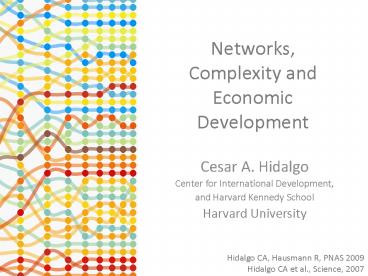Networks, Complexity and Economic Development - PowerPoint PPT Presentation
1 / 41
Title: Networks, Complexity and Economic Development
1
Networks, Complexity and Economic Development
- Cesar A. Hidalgo
- Center for International Development,
- and Harvard Kennedy School
- Harvard University
Hidalgo CA, Hausmann R, PNAS 2009 Hidalgo CA et
al., Science, 2007
2
Adam Smith, The Wealth of Nations 1776
3
Adam Smith, The Wealth of Nations 1776
4
Adam Smith, The Wealth of Nations 1776
5
Can we measure complexity?
6
The Lego Theory of Economic Complexity
7
To create a product you need to know the
elements that go into it and how they connect
To create a Lego model you need to know the
pieces that go into it and how they connect
8
(No Transcript)
9
(No Transcript)
10
Can we approach these questions without looking
at the bucket of Legos or knowing what the
Building Blocks are?
We do not know a priori which Lego models are
more valuable than others
11
We can try to grasp complexity, quantitative and
scientifically, as a problem of network structure.
12
Countries
Capabilities
Products
13
(No Transcript)
14
Intuition
15
(No Transcript)
16
(No Transcript)
17
(No Transcript)
18
(No Transcript)
19
Getting Technical
20
Method of Reflections
Degree (Countries)
Degree (Products)
21
Method of Reflections
kc,1 Average ubiquity of products exported by a
country
Product p1
Country C1
Product p2
Country C2
Product p3
Country C3
Product p4
22
Method of Reflections
Country
Product
23
The k0, k1 diagram
Primitive Productive Structure
Poorly Diversified Producing Common Products
Highly Diversified Producing Common Products
Average Ubiquity of a Countrys Productsk1
Highly Diversified Producing Exclusive Products
Poorly Diversified Producing Rare Products
Diversification k0
Complex Productive Structure
24
Dataset 1 (Year 2000)
Feenstra 129 countries 772 products (SITC-4)
How common are those Lego models
Number of Lego Models That You Make
Hidalgo, Hausmann (2009) PNAS
25
(No Transcript)
26
(No Transcript)
27
Hidalgo, Hausmann (2009) PNAS
28
Hidalgo, Hausmann (2009) PNAS
29
Method of Reflections 20 year Growth
(1) (2) (3) (4) (5) (6) (7) (8) (9) (10) (11)
PredictedVariable Growth(85,95) Growth(85,95) Growth(85,95) Growth(85,95) Growth(85,95) Growth(85,95) Growth(85,95) Growth(85,95) Growth(85,95) Growth(85,95) Growth(85,95)
Predictors
GDP per capita ppp(1985) -0.00176 0.000993 -0.00206 -0.00154 -0.00249 -0.00223 -0.00470 -0.00233 -0.00244 -0.00238 -0.00242
(-0.794) (0.533) (-0.882) (-0.497) (-0.735) (-0.688) (-1.478) (-0.758) (-0.849) (-0.804) (-0.831)
Entropy(1985) 0.00660 0.00828 0.00200 0.00322
(3.650) (2.600) (0.931) (0.896)
Herfindahl (1985) -0.0273 0.0116 -0.00414 0.00723
(-2.765) (0.760) (-0.406) (0.454)
k(1985) 6.62e-05
(2.080)
k1(1985) -0.000612
(-0.749)
k4(1985) 0.00169
(2.866)
k5(1985) 0.0321
(1.737)
k8(1985) 0.0338
(3.075)
k9(1985) 0.890
(2.713)
k18(1985) 0.401 38.88 35.05 37.26 35.57
(3.453) (2.952) (2.618) (2.849) (2.643)
k19(1985) 1127 1017 1080 1033
(2.928) (2.603) (2.829) (2.632)
Constant 0.0114 0.0137 0.00650 0.0338 -0.735 -19.29 -69.21 -23801 -21475 -22808 -21801
(0.751) (0.776) (0.437) (0.922) (-1.883) (-2.807) (-3.454) (-2.940) (-2.610) (-2.834) (-2.633)
N 97 97 97 97 97 97 97 97 97 97 97
Adjusted R2 0.195 0.115 0.192 0.118 0.206 0.247 0.202 0.274 0.274 0.268 0.268
30
Method of Reflections 5 year growth, fixed
country effects
(1) (2) (3) (4) (5) (6) (7) (8) (9) (10) (11)
Predicted Variables Growth(85-90-95-00-05) Growth(85-90-95-00-05) Growth(85-90-95-00-05) Growth(85-90-95-00-05) Growth(85-90-95-00-05) Growth(85-90-95-00-05) Growth(85-90-95-00-05) Growth(85-90-95-00-05) Growth(85-90-95-00-05) Growth(85-90-95-00-05) Growth(85-90-95-00-05)
Predictors
GDP per capita ppp(85,90,95,00) -0.0585 -0.0581 -0.0595 -0.0773 -0.0863 -0.0891 -0.0651 -0.0899 -0.0868 -0.0884 -0.0867
(-7.911) (-7.721) (-8.072) (-10.11) (-11.28) (-11.78) (-8.337) (-11.89) (-11.39) (-11.58) (-11.40)
Entropy(85,90,95,00) 0.0134 0.0247 0.00706 0.0142
(4.478) (4.037) (2.453) (2.435)
Herfindahl(85,90,95,00) -0.0390 0.0585 -0.0181 0.0360
(-2.842) (2.117) (-1.435) (1.410)
k(85,90,95,00) 0.000223
(3.710)
k1(85,90,95,00) 0.00238
(6.549)
k4(85,90,95,00) 0.000537
(2.922)
k5(85,90,95,00) 0.00366
(9.287)
k8(85,90,95,00) 0.000611
(2.801)
k9(85,90,95,00) 0.00410
(8.998)
k18(85,90,95,00) -0.000535 0.000601 0.000653 0.000618 0.000673
(-2.808) (2.801) (3.051) (2.879) (3.141)
k19(85,90,95,00) 0.00419 0.00395 0.00410 0.00389
(8.799) (8.164) (8.521) (8.031)
Constant 0.467 0.514 0.429 0.594 0.588 0.589 0.651 0.596 0.543 0.585 0.511
(7.427) (8.147) (6.592) (9.546) (8.165) (8.070) (8.203) (8.310) (7.315) (8.133) (6.583)
Observations 451 451 451 451 451 451 451 451 451 451 451
Within R2 0.2071 0.1784 0.2179 0.2991 0.3379 0.3373 0.1779 0.3372 0.3494 0.3415 0.3535
31
Analytical Theory Putting the Pieces together
32
Country
Product
Capability
33
Theoretical Prediction 3 The ubiquity of a
countrys products decreases with that countrys
level of diversification.
34
Bonus A Poverty Trap Model
35
Coordination Problem
36
Method of Reflections Predicts network
properties of future products
Hidalgo, Hausmann (2009) PNAS
37
Method of Reflections Predicts network
properties of future products
Hidalgo, Hausmann (2009) PNAS
38
CA Hidalgo, B Klinger, A-L Barabasi, R
Hausmann.Science (2007)
39
Malaysia
CA Hidalgo, B Klinger, A-L Barabasi, R
Hausmann.Science (2007)
1985
2000
40
Empirical Suggestive Evidence
Hidalgo, Hausmann (2009) PNAS
41
Thanks!(more info _at_ www.chidalgo.com, or google
cesar hidalgo)Hidalgo et al. Science
(2007)Hidalgo Hausmann, Development Alternatives
(2008)Hidalgo Hausmann, PNAS (2009)
Cesar A. Hidalgo, Research Fellow, Center for
International Development, Harvard
UniversityAdjunct Lecturer in Public Policy,
Harvard Kennedy School
Ricardo Hausmann, Director, Center for
International Development, Harvard
UniversityProfessor of the Practice of Economic
Development, Harvard Kennedy School

